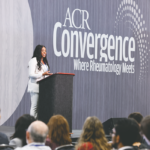
Chugunova Anastasia / shutterstock.com
TOWN HALL—When the COVID pandemic shifted meetings and other team functions in the working world to remote video encounters, team leaders were challenged to find new ways to build and support their teams. When the team could only come together remotely, the need for cohesion, morale building, recognition and common culture took on even greater importance. Some of the challenges and opportunities for building cohesion in teams forced by the pandemic to interact remotely were explored in the ACR’s May 6 virtual Division Director Town Hall.
Remote teamwork is new to rheumatology divisions and programs, noted Roberto Caricchio, MD, chief of the Section of Rheumatology, Temple University, Philadelphia, when introducing the speakers. “I don’t know about you, but I had no training in this matter, and I am still struggling to provide new ways of mentoring and leading.”
David Sluss, PhD, associate professor of organizational behavior, the Georgia Institute of Technology, Atlanta, and Adam Stoverink, PhD, associate professor and director of the MBA program at the Sam M. Walton College of Business, University of Arkansas, Fayetteville, explored the management challenges of team building in both one-on-one supervisory relationships and Zoom-based team meetings.
Rheumatology division directors may find their recommendations helpful both in the virtual world and in new, hybrid models combining in-person and remote work that are likely to emerge as the pandemic eases.
Effective one-on-one relationships with subordinates are essential for leaders, Dr. Sluss said. “During the pandemic, most—if not all—of our relational interactions have been virtual. These virtual work relationships and one-on-one interactions are here to stay,” he said. The challenge for leaders is how to make them feel more personalized.
He asked attendees to consider the ingredients of effective relationships with their superiors and to expect the same could apply to relationships with those they supervise. Participants identified good listening, availability, mutual respect, good and open communication, forthrightness, transparency, empathy, personal access to the leader as needed and—especially—trust as some of the key ingredients.
Research shows that relationships with subordinates are built on rewards, both tangible and intangible, and on support for their search for meaning and purpose in their work, Dr. Sluss said. Ultimately, these two approaches are the foundation of evidence-based strategies for building trust—which is inextricably tied to perceptions of fair treatment. Building trust takes time and effort.
For the leader, being too busy can be the enemy of perceived fairness, while demonstrating that one is less busy—and more available—enhances subordinates’ experience of feeling treated fairly. The challenge is that most leaders say they’ve become more busy, rather than less, during the pandemic. Conversations get rushed, technical tasks take precedence, and the perception of fairness by subordinates goes down.


